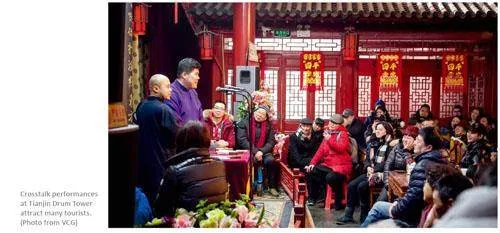Tianjin:Flourishing Grand Canal Hub
2024-08-21ZhangJingwen





The gurgling water ofthe Beijing-HangzhouGrand Canal nourishedthe birth and rise ofTianjin, the largest port city innorthern China. The canal passesthrough both Tianjin’s urban andrural areas, with a total length ofabout 190 kilometers within the city.
Tianjin was born because of theGrand Canal. From a vantage pointabove the city, it is clear that thesection of the Grand Canal flowingthrough Tianjin was formed by theconfluence of the two waterwaysfrom the south and north,respectively, which merge intothe Haihe River. The place wherethe three waterways meet forms aT-shaped area commonly knownas Sanchakou (meaning “ThreeForks”). “Sanchakou came first,”Tianjin locals often say, “and thencame Tianjin City.” This confluenceis both an important thoroughfarefor aquatic transportation in China’shistory and the cradle of Tianjin.
Tianjin prospered because ofthe Grand Canal. In the YuanDynasty (1271-1368), the citybecame a hub connecting domesticand foreign trade due to the hugedemand for transporting grain fromsouthern to northern China andfor sea transportation. The Tianjinsection of the Grand Canal wasbustling with abundant ships andconnected trade around the world.Its prosperity lasted for around 600years. The renowned Italian travelerMarco Polo (1254-1324) praised thisplace as a “heavenly city.”
The canal not only carriedTianjin’s river and maritimetransportation, but also witnessedthe germination and tortuousdevelopment of modern industryin the city. Starting in the 1860s,the Westernization Movementin the late Qing Dynasty (1644-1911) successively brought modernindustries to Tianjin includingthe Tianjin Machinery Bureau,Dagu Dockyard, and telegraphand telephone. By the turn of the20th century, dozens of industrialand mining enterprises wereestablished, and private businessmenalso invested in building factories.Tianjin gradually developed anindustrial structure with textiles,chemicals, and food industries aspillars.
The Grand Canal broughteconomic prosperity and culturalintegration and development as well.Cultures in southern China spreadto Tianjin through the Grand Canaland merged with local elements toform unique Tianjin culture. Forexample, Yangliuqing Township inXiqing District of Tianjin is hometo exquisite traditional buildingswith carved beams and paintedrafters. Surprisingly, some ofthe architectural styles there arecommon in southern China but rarein the north.
Yangliuqing woodblockNew Year paintings, perhapsthe most renowned of thefour major traditional Chinesewoodblock paintings, and a nationalintangible cultural heritage, alsoreceive nourishment from theGrand Canal. Originating inthe Ming Dynasty (1368-1644),Yangliuqing woodblock New Yearpaintings became popular in theQing Dynasty. Most of the materialsused to produce the paintings weretransported from the south via theGrand Canal. Plenty of businessesand shops operated in YangliuqingTownship, and “every family knewhow to paint and every householdexcelled at drawing.” Yangliuqingwoodblock New Year paintings arenow well-known both at home andabroad. Renowned contemporaryChinese writer and artist FengJicai once said: “Every place in theworld that houses a collection ofChinese paintings definitely featuresYangliuqing woodblock New Yearpaintings.”
As merchants and businessgroups from all over the countrycame to Tianjin during the Mingand Qing dynasties, the cultureof Tianjin became more diverse.A variety of traditional operassuch as Peking Opera and PingjuOpera are performed there.Craftsmen from across Chinamigrated and settled there, kindlingintangible cultural heritage suchas Niren Zhang clay figurines andShibajie fried dough twists. In earlymodern times, Tianjin began tobe influenced by Western culture.The city was home to China’sfirst military school, first modernuniversity, and first kindergarqDgkbkxhXPK/gziHRGUw==arten.Tianjin people are warm andstraightforward. They are openmindedand easily accept new ideas.Their open-mindedness was largelyshaped by the Grand Canal.
The Grand Canal was inscribedon the UNESCO World HeritageList in 2014, becoming the 46thWorld Heritage site in China. Theconfluence of the sections of thecanal in the south and north inTianjin became the city’s secondWorld Cultural Heritage site in thecity after the Great Wall.
In the new era, the magnificentscenery of the canal capturesTianjin’s achievements in protectingthe canal ecology and passingon the canal culture, serving as amicrocosm of Tianjin’s high-qualitydevelopment. In 2015, JinghaiDistrict established Tianjin’sfirst canal culture museum:Chenguantun Canal CultureMuseum, where thousands ofcultural relics and hundreds ofimages track the development of theGrand Canal. Several Grand Canalthemedcultural parks have beenbuilt in Tianjin. They have becomea wonderful choice for ecologicalleisure tours.
Now, Tianjin serves as themaritime gateway of the Beijing-Tianjin-Hebei region, the sea-landintersection of the Belt and RoadInitiative, the eastern startingpoint of the China-Mongolia-Russia Economic Corridor, and animportant hub of the New EurasianContinental Bridge EconomicCorridor. Over the past decade,the annual container throughputof Tianjin Port has increased from13 million TEUs to 21 millionTEUs. The port has ranked amongthe top ten ports in the world formany years in a row. The AirbusTianjin final assembly line has beenin operation for 15 years and isintegrated into the development ofChina’s aviation industry. Over thepast eight years since its inception,the China (Tianjin) Pilot Free TradeZone has deepened systematic andintegrated institutional innovationwhile striving for high-qualitydevelopment.
